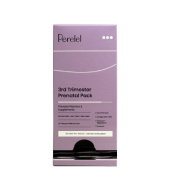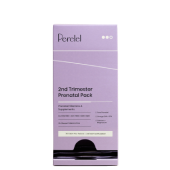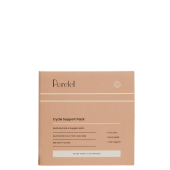Perimenopause is the natural transition leading up to menopause, marked by shifting hormone levels and changes to your cycle, sleep, mood, and more. It can last anywhere from two years to over a decade.
While nearly all women experience it eventually, the symptoms look different for everyone. For some, it’s a handful of mild changes; for others, it can feel like a rollercoaster of hot flashes, unpredictable periods, and brain fog.
This guide breaks down the full range of perimenopause symptoms, what typically happens in early versus late transition, and the most common strategies for relief.
Perimenopause Symptoms
Perimenopause symptoms don’t look the same for everyone. Some women notice big, obvious changes while others only have a few subtle shifts. Symptoms can come and go, ramp up, or ease off again. To support your hormones as they fluctuate, bolster your routine with a steady drumbeat of nutrients designed specifically for this hormonal life stage with a Perimenopause Support Pack.
Here’s the full picture (organized by type) so you know what might pop up. And if you’d rather skip ahead to solutions, you can scroll down to relief options.
Cycle Changes
- Irregular periods (common): Your period may suddenly come earlier, later, or disappear for a month. This is usually the first sign many women notice.
- Heavier or lighter flow (common): Some cycles may feel like a flood, while others barely show up. Both can be normal during perimenopause.
- Shorter or longer cycles (common): Instead of the usual 28 days, your cycle might shrink to 21 days or stretch to 40.
- Spotting (less common): Light bleeding between periods sometimes happens, though if it’s frequent or painful, check in with your doctor.
Vasomotor Symptoms
- Hot flashes (very common): A sudden wave of heat that spreads through your body, often with sweating and a red face. They usually last a few minutes.
- Night sweats (very common): Hot flashes that wake you up at night, often leaving sheets damp or disrupting your sleep.
Sleep Symptoms
- Trouble falling asleep (common): Lying awake staring at the ceiling becomes more frequent.
- Waking too early (common): You may find yourself wide awake at 4 a.m. and unable to drift back off.
- Daytime fatigue: Poor sleep quality can spill over into the day, leaving you foggy, irritable, or feeling like you’re running on fumes.
Mood and Cognitive Symptoms
- Irritability (common): Little things may set you off more easily.
- Anxiety (common): Worry or nervousness can show up even if you’ve never struggled with it before.
- Low mood (common): Feeling down, flat, or unmotivated is common during hormone shifts.
- Brain fog (common): Losing your train of thought, forgetting what you walked into the room for, etc.
- Memory blips (less common): Occasionally misplacing things or forgetting details can happen to some women more than others.
Physical Symptoms
- Breast tenderness (common): Breasts can feel swollen, sore, or sensitive outside of your normal cycle.
- Headaches or migraines (common): Hormonal swings can trigger new headaches or make existing ones worse.
- Aches and stiffness (common): Joints and muscles may feel achier, especially in the morning.
- Weight shifts (common): Many women notice weight settling more around the belly than the hips or thighs.
- Bloating (common): Digestion may feel off, leading to more bloating or gas than usual.
- Water retention (common): Puffy hands, ankles, or feet can come and go.
Urogenital and Sexual Symptoms
- Vaginal dryness (common): Lower estrogen can make natural lubrication less reliable.
- Discomfort during sex (common): Dryness or thinning tissue may make intercourse less comfortable without added support.
- Frequent UTIs (less common): Vaginal tissue changes can make urinary infections more likely for some women.
- Libido changes (common): Sex drive may dip, rise, or swing back and forth throughout this stage.
Skin and Hair Symptoms
- Dry skin (common): Skin may feel rougher, itchier, or more sensitive.
- Breakouts (less common): Acne may flare up again, or, for some, clear up completely.
- Hair thinning (common): Hair can feel less full, with more shedding than before.
Other, Less-Discussed Symptoms
- Heart palpitations (less common): Your heart may race or feel like it’s skipping a beat.
- Dizziness (less common): Brief spells of feeling lightheaded sometimes occur.
- Itchy or crawling skin (less common): Some women describe prickly or “bugs under the skin” sensations, called formication.
- Tingling (less common): Pins-and-needles in the hands or feet can crop up.
- Ringing in the ears (less common): Tinnitus or hearing shifts occasionally appear in perimenopause.
Early Signs & Timeline
One of the trickiest parts of perimenopause is knowing when it actually starts. For most women, the first sign is a shift in their menstrual cycle. Your period might show up earlier or later than usual, get heavier or lighter, or even skip a month. These changes often happen before hot flashes or sleep issues begin.
- Early transition: In the beginning, cycles are still happening regularly but may feel “off.” You might notice PMS symptoms feel stronger, your period lasts longer, or there’s spotting between cycles. This stage can last several years.
- Late transition: As your ovaries slow down further, the gaps between cycles get longer. Symptoms like hot flashes, night sweats, and vaginal dryness are more likely to appear or get more intense. Eventually, periods stop altogether. Menopause is confirmed once you’ve gone 12 months without a period.
- When it starts: Most women begin perimenopause in their 40s, but it can start as early as the mid-30s or as late as the early 50s. Family history, lifestyle, and health factors all play a role.
- How long it lasts: Perimenopause can last a couple of years or stretch closer to a decade. On average, the transition lasts about four years before reaching menopause.
- Why it feels inconsistent: Hormone levels don’t drop in a straight line. Estrogen and progesterone fluctuate up and down, which is why you might feel “back to normal” one month and notice new symptoms the next.
Every timeline is unique, but if your cycle is changing and symptoms are popping up in your 40s, chances are you’re in perimenopause.
When To See a Doctor
Most perimenopause symptoms are uncomfortable but not dangerous. Still, there are certain situations where it’s smart to call your doctor rather than try to manage things on your own.
Symptoms to pay close attention to:
- Bleeding so heavy that you soak through a pad or tampon every hour, or pass large clots
- Any vaginal bleeding after you’ve gone 12 months without a period (postmenopause)
- Severe pelvic pain or cramping that interferes with daily life
- Sudden mood changes, especially if they affect your safety or mental health
- Chest pain, palpitations, or dizziness combined with other symptoms
- Unexplained weight loss, new severe headaches, or neurological changes
- The possibility of pregnancy (yes, it can still happen during perimenopause)
How to prepare for your appointment:
- Keep a symptom diary, noting what you feel and when
- Track your menstrual cycle: length, flow, and skipped periods
- Make a list of any medications and supplements you take
- Think about your goals: Are you looking for symptom relief, contraception, or both?
Having this information ready helps your clinician see the bigger picture and guide you toward safe, effective options.
How Perimenopause Is Diagnosed
Unlike some health conditions, there isn’t a single test that says, “Yes, you’re in perimenopause.” Diagnosis is based mostly on your age, symptoms, and cycle patterns. Your provider will start with a detailed history, looking at changes in your periods, hot flashes, sleep shifts, mood changes, and any other symptoms you’ve noticed.
Why not just a blood test?
Hormones like FSH (follicle-stimulating hormone) and estradiol fluctuate a lot during this transition. A single blood draw may show high or low levels depending on the day, but that doesn’t necessarily confirm where you are in the process. Because of that, hormone tests on their own are not considered reliable for diagnosing perimenopause.
When tests can help
Your clinician may order labs to rule out other possible causes of your symptoms or to check your overall health:
-
Pregnancy test: to confirm symptoms aren’t related to pregnancy, since ovulation can still occur
-
Thyroid function tests: to rule out thyroid issues, which can mimic hot flashes, mood changes, or cycle irregularities
-
Iron studies: to check for anemia if you’re dealing with heavy or prolonged bleeding
-
A1C or lipid panel: to monitor blood sugar and cholesterol as part of midlife health
-
Other labs: as indicated by your health history
Imaging tests (like ultrasound) are generally not needed unless you have red-flag symptoms such as unexplained pelvic pain, very heavy bleeding, or concern for fibroids or other uterine changes.
Perimenopause is usually a clinical diagnosis, meaning it’s based on your symptoms and life stage, not one number on a lab slip. The best approach is a collaborative one: share your full picture with your provider, ask questions, and discuss your goals (whether it’s symptom relief, contraception, or both). Together, you can create a plan that feels safe, informed, and tailored to your needs.
Relief Options for Perimenopause Symptoms
Perimenopause can feel unpredictable, but there are many ways to ease symptoms and support your wellbeing. Think of relief in layers, starting with everyday foundations, then adding targeted options when needed.
Build a Strong Foundation
These habits make a difference no matter what symptoms you’re facing:
-
Prioritize sleep hygiene: Keep a consistent bedtime, limit screens before bed, and keep your room cool and dark.
-
Move your body: A mix of cardio and strength training helps support mood, bone health, and metabolism. Even daily walks count.
-
Manage stress: Try mindfulness, yoga, journaling, or just carving out downtime. Stress often makes hot flashes and sleep issues worse.
- Nutrition matters: Aim for balanced meals with protein, fiber, and healthy fats. Cutting back on caffeine and alcohol can help stabilize sleep and reduce hot flashes.
Symptom-Targeted Relief
If foundations aren’t enough, these strategies may help with specific concerns:
Vasomotor symptoms (hot flashes, night sweats):
- Layer clothing and keep your sleep space cool.
- Some women explore menopausal hormone therapy (MHT/HRT) with their clinician.
- Non-hormonal options your provider may discuss include certain SSRIs/SNRIs, gabapentin, or clonidine.
Mood and sleep changes:
-
Cognitive Behavioral Therapy for Insomnia (CBT-I) is a proven, non-drug option.
- Build a wind-down routine, like reading, stretching, or calming music.
- If anxiety and depression feel overwhelming, talk to your provider about therapy or medication support.
Urogenital and sexual symptoms:
- Vaginal moisturizers and lubricants can ease dryness and discomfort.
- A clinician may suggest low-dose vaginal estrogen, which acts locally to support vaginal tissue.
Heavy or irregular bleeding:
- Over-the-counter NSAIDs (like ibuprofen) taken at the right time can reduce bleeding and cramps.
- Your provider may also discuss options like a hormonal IUD (LNG-IUD) or combined hormonal birth control to regulate cycles and lighten flow.
Support From Supplements
At Perelel, we designed the Perimenopause Support Pack to provide nutrients that can help maintain balance through hormonal shifts. Each daily pack contains doctor-formulated essentials tailored for this life stage, including ingredients that support energy, sleep quality, and overall wellness.*
Important reminders:
- Always discuss new treatments or supplements with your clinician. What works best depends on your health history, goals, and symptoms.
- Don’t forget contraception: Fertility is still possible until you’ve gone 12 months without a period.
Relief is not one-size-fits-all. Combining lifestyle shifts, supportive care, and medical options guided by your provider can make the transition through perimenopause more manageable and empowering.
Frequently Asked Questions
What are the first signs of perimenopause?
The first signs often show up as changes in your menstrual cycle. Your periods might become shorter, longer, lighter, or heavier than before. Skipped cycles can happen, too. Other early signs include hot flashes, night sweats, trouble sleeping, mood swings, and vaginal dryness.
Some people also notice brain fog, fatigue, or shifts in libido. Because these symptoms overlap with stress, thyroid issues, and other conditions, it’s important to track your cycle and symptoms. If you’re noticing consistent changes, it may be worth checking in with your healthcare provider.
How long does perimenopause last?
Perimenopause can last anywhere from two to 10 years, though the average is about four years. This stage ends one year after your final period, which marks the start of menopause. Symptoms don’t follow a straight line; many women experience stretches of feeling “normal” before symptoms flare again.
Genetics, lifestyle factors, and medical history all influence how long perimenopause lasts. If your symptoms feel disruptive or are impacting your daily life, you don’t have to just wait it out. There are medical and lifestyle strategies that can help ease the transition.
Can perimenopause start in your 30s?
Yes. While the most common age range for perimenopause to begin is between 40 and 45, some women notice symptoms in their mid-to-late 30s. Starting before age 40 is less common but possible. In some cases, it may signal primary ovarian insufficiency (POI), where ovarian function slows earlier than expected.
Family history, medical conditions, and lifestyle factors can influence when symptoms appear. If you’re under 40 and experiencing irregular cycles, hot flashes, or other changes, it’s a good idea to see your doctor to rule out other causes and confirm whether perimenopause has started.
What’s the difference between PMS and perimenopause?
PMS happens in the luteal phase of a normal menstrual cycle and resolves once your period starts. It’s tied to the predictable hormone rise and fall each month. Perimenopause symptoms, by contrast, are caused by fluctuating estrogen and progesterone as ovarian function declines.
The difference is consistency: PMS follows a pattern each cycle, while perimenopause symptoms can show up randomly and often feel more intense or longer-lasting. For example, mood swings, hot flashes, or brain fog might appear even when you’re not close to your period. Tracking timing can help you tell the difference.
Do hormone tests help confirm perimenopause?
Hormone tests are not always reliable for confirming perimenopause. FSH, LH, and estrogen levels naturally fluctuate from day to day during this stage, so a single blood test can’t give a clear answer.
Diagnosis is usually based on your age, cycle changes, and symptoms. That said, your provider may order lab tests to rule out other issues with similar symptoms, like thyroid disease, anemia, or pregnancy. In some cases, repeated tests over time can provide supporting information, but your history and experience are the most important clues.
Can I get pregnant during perimenopause?
Yes. Even though fertility declines during perimenopause, ovulation still happens occasionally, which means pregnancy is possible. Experts recommend using contraception until you’ve gone a full 12 months without a period, which is the definition of menopause.
If you’re not planning to conceive, talk with your provider about birth control options that also help regulate cycles or manage symptoms. If you are hoping to become pregnant, mention it to your doctor as early as possible so they can guide you with fertility-supportive options and check your overall reproductive health.
What helps hot flashes at night?
Hot flashes and night sweats can make sleep tough, but a few strategies help. Keep your bedroom cool and dark, use moisture-wicking sheets, and dress in breathable layers. Limit caffeine, alcohol, and spicy foods in the evening, as these can trigger heat surges.
A consistent bedtime routine with relaxation techniques, like stretching, meditation, or warm showers, can calm your body before sleep. If lifestyle changes aren’t enough, talk to your clinician. Options like hormone therapy or certain non-hormonal medications may provide relief.
Conditions That Mimic Perimenopause
Perimenopause can cause a wide range of symptoms, but it’s not the only explanation. Several medical conditions look similar because they also affect hormones, energy, sleep, and mood. That’s why it’s important not to assume every change is just “getting older.”
Here are some common conditions that can overlap with perimenopause, plus how they’re different.
| Condition | Distinguishing Clues |
|---|---|
| Thyroid disorders | Can cause fatigue, weight changes, hair thinning, or temperature sensitivity. Blood tests confirm thyroid function. |
| Anemia (low iron) | Triggers fatigue, weakness, pale skin, and feeling unusually cold. Often linked to heavy periods. |
| Pregnancy | Missed periods, breast tenderness, fatigue, and mood changes may mimic perimenopause. A pregnancy test can clarify. |
| Depression/anxiety (unrelated to cycle) | Persistent low mood, anxiety, or brain fog that doesn’t improve with cycle changes. |
| Medication side effects | Some antidepressants, blood pressure drugs, or steroids can disrupt cycles or cause hot flashes. |
| PCOS (polycystic ovary syndrome) | Irregular cycles and hormonal shifts, often starting much earlier than typical perimenopause. |
| Fibroids | Noncancerous uterine growths that can cause heavy bleeding, pelvic pain, or pressure. |
| Diabetes | Fatigue, frequent urination, or weight shifts that don’t follow a cycle pattern. |
| Sleep apnea | Night sweats, fatigue, and poor sleep linked to breathing interruptions rather than hormone changes. |
When in doubt, see a clinician. A clear history, physical exam, and a few tests can help separate perimenopause from other conditions and ensure you get the right support.
Talking to Your Clinician
It’s not always easy to bring up perimenopause, especially if your symptoms feel vague or inconsistent. Preparing a few talking points ahead of your appointment can make the conversation more focused and productive. Here are sample scripts you can adapt to your own situation:
- Hot flashes/night sweats: “I’m having sudden heat waves during the day and sweating at night. They’re waking me up and affecting my energy. What options do I have for relief?”
- Cycle changes: “My periods have become irregular, sometimes heavier and sometimes lighter. I’m worried about whether this is normal or if more testing is needed.”
- Low mood, brain fog, or poor sleep: “I’ve been feeling more anxious, foggy, and tired than usual, and it’s affecting my work and relationships. Can we talk about ways to improve my sleep and mood?”
- Urogenital changes: “I’ve noticed dryness and discomfort during sex. What safe options are available to help?”
Bring a symptom diary, a list of your medications and supplements, and your main goals (whether it’s relief, contraception, or both). Being specific helps your clinician suggest options that match your needs and preferences.
Key Takeaways
Perimenopause isn’t something to power through alone. It’s a major life stage that deserves care, clarity, and support. Whether your symptoms are barely noticeable or disrupting your daily routine, knowing what’s happening inside your body can help you feel less blindsided and more prepared.
This guide covered the signs, stages, and options for relief, but remember: your experience is uniquely yours. Some women breeze through with just a few irregular cycles, while others deal with years of hot flashes, brain fog, or sleep changes. Both are normal, and both deserve attention.
The good news? You don’t have to guess where you stand. Taking a quick, expert-designed quiz can help you better understand your symptoms and give you a clearer idea of whether perimenopause might be the culprit. It’s not a diagnosis, but it’s a helpful first step toward feeling more in control and a great tool to bring to your next doctor’s visit.
Perimenopause may be unpredictable, but you’re not powerless. With the right knowledge, lifestyle shifts, and support from your clinician, this transition can be more manageable than it feels today. Start by learning where you are along the journey. Take our quiz now and get tailored insights you can use right away.
This article is for informational purposes only. It is not, nor is it intended to be, a substitute for professional medical advice, diagnosis, or treatment and we recommend that you always consult with your healthcare provider. To the extent that this article features the advice of physicians or medical practitioners, the views expressed are the views of the cited expert and do not necessarily represent the views of Perelel.
Sources:
Perimenopause - Symptoms and causes | Mayo Clinic
Perimenopause: Age, Stages, Signs, Symptoms & Treatment | Cleveland Clinic






















